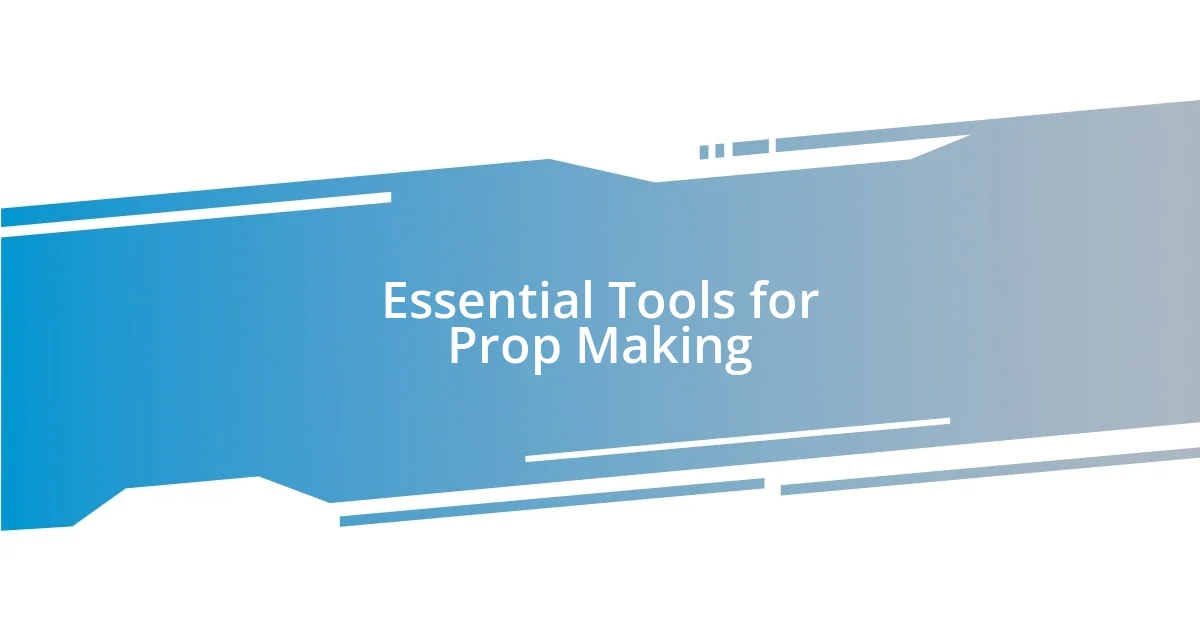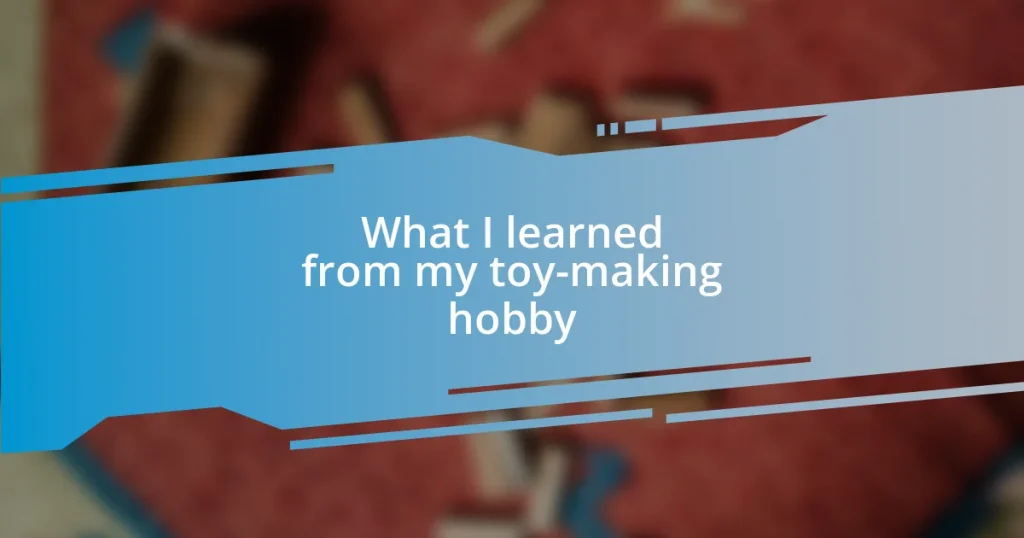Key takeaways:
- Key tools for prop making include a multi-tool knife, hot glue gun, and various types of foam, which enhance versatility, speed, and creativity in projects.
- Common materials such as foam board, plywood, and thermoplastic sheets like Worbla are essential for creating lightweight, durable, and intricately designed props.
- Effective techniques like painting, texturing, and using realism references can significantly improve the authenticity of props, while inspiration can be drawn from nature, films, and community collaboration.

Essential Tools for Prop Making
When I first ventured into prop making, I quickly realized the importance of having the right tools at hand. A multi-tool knife became my best friend—its versatility allowed me to cut, scrape, and even create intricate details with ease. Have you ever been in a situation where a single tool can solve multiple problems? That feeling of having everything you need in one place is invaluable.
Beyond that, a reliable hot glue gun is essential for attaching elements together quickly. I can still remember the exhilarating chaos of my first project, where I had to complete a prop overnight. The hot glue gun was my savior, solidifying pieces in seconds and letting me focus on the creative aspects instead of waiting for drying times. It’s amazing how such a simple tool can make you feel like a magician, bringing your ideas to life right before your eyes.
Another essential tool that I can’t emphasize enough is foam. Whether it’s EVA foam for costumes or polystyrene for set pieces, learning how to manipulate foam transformed the way I approached prop making. I find myself constantly amazed at how lightweight yet durable it is. Have you tried it? The possibilities are endless, and working with it has brought both challenges and incredible satisfaction. It’s more than just a material; it’s a gateway to creativity, allowing me to experiment and expand my skills.

Materials Commonly Used in Props
When it comes to prop making, the choice of materials can significantly impact the final result. One of the most commonly used materials is foam board, which I’ve found to be incredibly versatile. During one of my early projects, I crafted a quirky monster using foam board for its body. The material’s lightweight nature made it easy to handle, and I remember how satisfying it was to bring my vision to life, quickly cutting shapes and assembling them without much hassle. It struck me how this simple material could make my ideas tangible.
Another favorite of mine is wood, especially when I need sturdiness in my props. In one memorable project, I decided to create a medieval-style shield. I chose plywood, which provided both strength and a great surface for painting. As I sanded down the edges, I felt this connection to traditional craftsmanship. I love how wood brings a sense of authenticity to props, whether you’re going for a rustic vibe or a polished finish. It’s profound to think about how a raw material can transition into something visually stunning.
Lastly, I can’t overlook the value of thermoplastic sheets like Worbla. These materials are a game-changer. They can be heated and shaped to create intricate details that would be otherwise impossible with standard materials. I remember the rush I felt while molding a helmet for a cosplay project—seeing it transform with just a bit of heat and effort was nothing short of exhilarating. The first time I used Worbla, I was amazed at how forgiving it was; if I made a mistake, a little heat could fix it. This adaptability encourages experimentation, making failures feel less daunting and the process much more enjoyable.
| Material | Common Uses |
|---|---|
| Foam Board | Lightweight props, costume elements |
| Plywood | Durable structures, detailed carvings |
| Thermoplastic (Worbla) | Forms intricate designs, cosplay gear |

Techniques for Creating Realistic Props
Creating realistic props requires a mix of techniques that elevate your projects from simple to stunning. One technique I’ve found invaluable is adding texture to surfaces. For example, I remember the first time I experimented with paint layering. I used a base coat, then added sponges with different shades to create a weathered look on a wooden sword. The satisfaction of seeing it transform from a flat surface to something that looked genuinely aged was exceptional. That moment reinforced my belief that small details truly matter.
Here are some key techniques to consider for your prop-making journey:
- Layering Paint: Start with a solid base coat, then build depth with various shades using sponges or brushes.
- Creating Texture: Incorporate materials like sand, fabric, or textured paints to simulate real surfaces.
- Using Realism References: Study real objects or photos for accurate details, helping to emulate the look in your props.
- Weathering Techniques: Use dry brushing or washes to add signs of wear and tear, making items appear used and authentic.
- Backing with Cardboard or Wood: For props meant to stand or bear weight, always consider a sturdy backing for support.
These techniques can breathe life into your creations, making them not just props but lifelike representations of the stories they’re meant to tell.

Inspiration Sources for Prop Ideas
Finding inspiration for prop ideas can come from the most unexpected places. I often browse through nature trails and find intriguing shapes and textures that spark my creativity. Just the other day, I stumbled upon an old tree stump that had a twisty, gnarled appearance. I immediately envisioned a series of fantasy props, perhaps a mystical wand or a spellbook cover that echoed nature’s beauty. Have you ever noticed how the world around us can ignite our imagination?
I also find immense inspiration in films and video games. The rich worlds depicted in these mediums are often filled with elaborate props that tell their own stories. I vividly recall watching a fantasy movie where the hero wielded a striking sword covered in runes. That detail resonated with me, and I set out to replicate that look in my own project. The thrill of transforming that cinematic wonder into a tangible prop was electrifying. Isn’t it so rewarding to take inspiration from something you love and turn it into your unique creation?
Don’t underestimate the impact of community and collaboration either. Joining local prop-making meet-ups has introduced me to fellow enthusiasts brimming with ideas. I still remember a brainstorming session when someone shared sketches of mythical creatures. We all dove deep into discussions, and suddenly, I had a flood of concepts for a new set of interchangeable puppet heads. Working together can breathe new life into your creativity, don’t you think? Inspiration truly is everywhere, and often, it’s just a conversation away.

Tips for Showcasing Your Props
When it comes to showcasing your props, lighting is one of the most critical elements. I still remember the first time I illuminated a prop for a photoshoot. With the right angle and soft lighting, that simple dagger transformed into a dramatic centerpiece. It’s incredible how a well-lit display can accentuate details, adding depth and intrigue—have you ever seen your creations come to life under different lights?
Additionally, consider creating a themed backdrop that complements your prop. During my last showcase, I used a rustic wooden table, giving a medieval vibe to a collection of fantasy artifacts. This approach not only enhanced the visual appeal but also immersed viewers in a story. A backdrop can transport your audience, making them feel part of the world you’ve crafted. Doesn’t it just elevate the experience when props are presented within their narrative context?
Lastly, I highly recommend sharing your props on social media and engaging with fellow creators. When I first posted my props online, I was surprised by the overwhelming support and feedback from the community. It spurred me to improve and experiment more. Plus, engaging conversations can spark new ideas and collaborations. Have you shared your creations online? There’s something truly fulfilling about being part of a community that appreciates the art of prop-making just as much as you do.
















